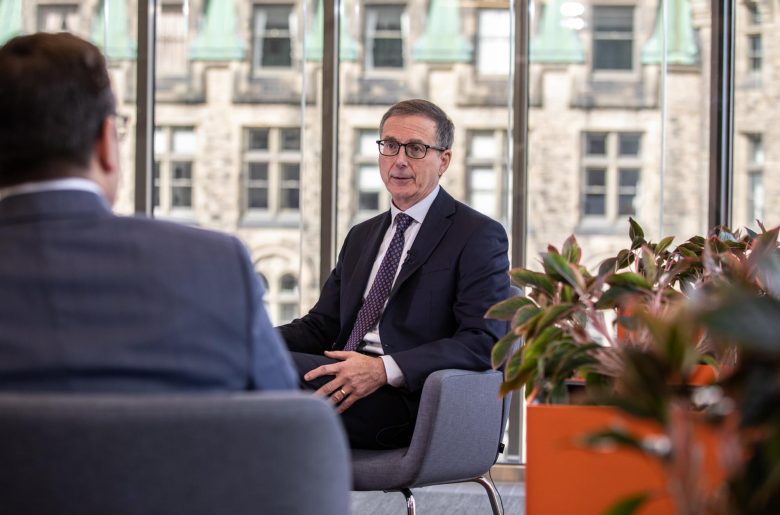
Governor's foreword
The end of 2021 felt much like the beginning—full of cautious optimism but clouded by near-term uncertainty about the path of the COVID‑19 pandemic and its impact on the economy. But in fact much has changed.
During the year, shutdowns and public health restrictions gave way to vaccinations and a large-scale reopening of businesses. As a result, the economy grew vigorously during the second half of 2021. And as the recovery gained strength, we adjusted our monetary policy support—reducing and eventually ending quantitative easing in October.
But restarting the global economy also brought new challenges. The unique circumstances of the pandemic spurred a global surge in the demand for goods and disrupted global supply chains. Shutdowns and ongoing public health protocols in many countries hindered production and transportation, leading to sharply higher prices for many goods in Canada and around the world. Largely as a result, inflation in many countries increased substantially. In Canada, consumer price index inflation rose well above the Bank’s 1% to 3% control range, reaching 4.8% in December. That has made it harder for Canadians to make ends meet—particularly those with low incomes.
In 2021, the Bank and the Government of Canada renewed our agreement on Canada’s monetary policy framework. The agreement reaffirms that price stability is the primary objective of monetary policy.”
Tiff Macklem, Governor
In 2021, the Bank of Canada and the Government of Canada renewed our agreement on Canada’s monetary policy framework. The agreement reaffirms that price stability is the primary objective of monetary policy with a 2% inflation target. The renewed agreement provides continuity and clarity and strengthens our framework to manage the realities of the world we live in. This is the framework Canada needs now as we confront elevated inflation and the challenges of reopening the economy. And, looking beyond the pandemic, it is what we need for the future.
Throughout 2021, we sought to better understand the complexities of the economic recovery. We used innovative tools and approaches to help us assess the impact of global supply disruptions, better understand the drivers of elevated inflation and better interpret labour market developments. We exchanged information and insights with our global counterparts. All of this work played a vital role in informing and guiding our monetary policy decisions.
We also kept a close eye on Canada’s housing market. We worked to understand how shifting housing preferences and continued strong demand contributed to financial vulnerabilities as some households stretched their budgets to buy houses, taking on elevated levels of debt relative to their incomes. This work included analysis of extrapolative expectations in major housing markets across Canada as well as the growing impact of investors on housing demand.
Amid all the uncertainty, we maintained our commitment to transparency and promoted public understanding and trust through effective communications and engagement.
Of course, our work went beyond the challenges of the pandemic.
We continued to improve our understanding of the economic and financial system risks associated with climate change. Working with the Network for Greening the Financial System, we developed strategies to mitigate transition risks and promote sustainable finance. In partnership with the Office of the Superintendent of Financial Institutions and the financial services industry, we developed and conducted scenario analysis to assess how the economy and financial system may be affected by the transition to a lower-carbon economy. We also launched a new greening strategy for the Bank itself, with concrete targets to reduce greenhouse gas emissions across the Bank’s operations.
We continued our focus on both our operational resilience and the resilience of the financial system, including a new cyber security strategy focused on response and recovery capabilities.
Through research and outreach, we advanced our understanding of Canadians’ evolving use of cash and preferred payment methods. We also continued the modernization of our bank note processing centres and contributed to the launch of Canada’s new large-value payment system, Lynx. And, looking to the future, we accelerated our work exploring the benefits and design of a central bank digital currency.
In 2021, the Bank added a fifth core function, with a new mandate for retail payments supervision in Canada. We began to lay the foundation for our new risk monitoring and enforcement activities and started work on our approach to register payment service providers.
In addition to performing the core functions that Canadians count on us for, we evolved and affirmed the values that underpin the work we do—to think ahead, include everyone and inspire confidence. And we set the stage for the years ahead with the launch of our 2022–24 strategic plan, Delivering on Our Promise. This strategic plan responds to our rapidly evolving environment, while allowing our goals to remain ambitious. It is the roadmap for an organization that is truly dynamic, engaged and trusted—no matter what challenges we face.
No matter what 2022 brings, we will continue to promote the economic and financial well-being of Canadians from coast to coast to coast.”
Tiff Macklem, Governor
We implemented a robust strategy to support equity, diversity and inclusion. This included new targets for improved diversity at the Bank and scholarships for racialized students. We also had collaborative discussions with G7 central banks on how to accelerate progress on diversity and inclusion in our institutions and in economics and finance more broadly. And we strengthened our engagement with Indigenous Peoples, co-founding the Central Bank Network for Indigenous Inclusion and co-hosting the first Symposium on Indigenous Economies.
Finally, COVID‑19 prompted us to look at how we work during a pandemic and beyond. We have made significant progress in making sure our physical and online spaces—as well as our employees—are ready for a new hybrid work model.
The year 2021 ended on a high note. First, in December, we welcomed the Bank’s new Senior Deputy Governor, Carolyn Rogers. She joins a formidable team of dedicated public servants who have consistently demonstrated their integrity and professionalism, despite the personal challenges the year brought. And, second, we were named as one of Canada’s Top 100 Employers for the 12th consecutive year and one of Canada’s Best Diversity Employers.
On behalf of the Bank’s Board of Directors and staff, I pledge the Bank’s continued service to Canadians as we face new challenges in the year ahead. No matter what 2022 brings, we will continue to promote the economic and financial well-being of Canadians from coast to coast to coast.
Canadians can count on us.
Tiff Macklem
Governor
